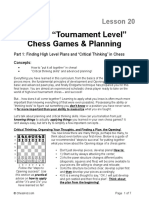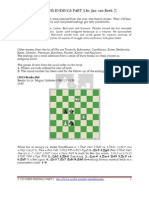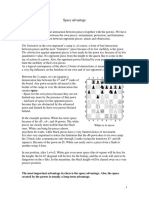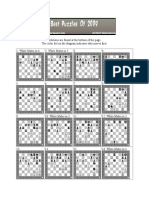Introduction To Chess Strategy: by Steve Lopez
Introduction To Chess Strategy: by Steve Lopez
Uploaded by
yourstruly999Copyright:
Available Formats
Introduction To Chess Strategy: by Steve Lopez
Introduction To Chess Strategy: by Steve Lopez
Uploaded by
yourstruly999Original Title
Copyright
Available Formats
Share this document
Did you find this document useful?
Is this content inappropriate?
Copyright:
Available Formats
Introduction To Chess Strategy: by Steve Lopez
Introduction To Chess Strategy: by Steve Lopez
Uploaded by
yourstruly999Copyright:
Available Formats
Introduction to Chess Strategy
Do you play poker? There are many similarities in strategies between chess and Texas holdem and chess players are starting to take notice. In both games, you must think a number of moves ahead and gather as much information as you possibly can. It's no accident that expert poker players such as Bob Chiaffone and Howard Lederer are great at chess.
Opening Chess Strategy by Steve Lopez
Beginning chess players discover very quickly that learning how the pieces move is just the tiniest tip of the tip of the iceberg. It's usually sometime during the first several moves of their very first game that they find themselves saying, "What now?" We're going to provide you with some very simple, easy guidelines in chess strategy for playing the chess opening. We're not going to talk about specific openings or give you strings of moves to memorize; these will be some general chess strategy principles which you should think about when starting a chess game. As your chess career continues you'll also notice that there will be times when it's best to ignore some of these chess strategy and opening principles. Nothing here is carved in granite and there will be times later when you'll violate one or more of these principles. But for right now, these tips are good ones to follow during the first few moves of your games. An underlying principle in the chess strategy of the chess opening is to try to control the center of the board. The board's center is typically defined as the four squares right in the middle of the board (shown here in red):
The center is important because your pieces tend to be more mobile the closer they are to the center. Here's an example using the Knight:
The centrally-placed Knight can move to (and control) eight squares. Now look at this Knight:
This Knight in the corner controls just two squares. Center occupation and center control are the two principles of chess strategy which underlay almost all popular chess openings. White would like to occupy the squares d4 and e4 with his pawns, like so:
...while Black's chess opening strategy is to occupy both d5 and e5 with his own pawns:
Both players are also trying to prevent their opponent from achieving his goal (so, in most chess openings, neither player actually achieves it), but it's a good opening chess strategy for which both usually strive. The pawns can't stand alone on these squares, either; they need to be supported by other pieces or pawns. Remembering this will help you to understand some of the principles we're about to discuss. 1) Good chess strategy suggests you make your first move with the pawn in front of either your King or Queen Probably the simplest of all chess opening strategies. In both cases, you'll be opening up paths which your other pieces can use to get off of the back rank:
2) Good chess strategy suggests you make good developing moves, and generally develop your Knights before your Bishops A good developing move is one which gets a piece off of its starting square. This is an important chess strategy: you want to get your pieces into the game (where they can actually accomplish something, either aiding your attack or defense) as soon as you can. And the reason why you'll usually want to develop your Knights before your Bishops is because it's easier to find a good place for your Knights:
This is an example of a "can't go wrong" Knight development; the Knights defend the pawns and control those strategically important central squares. Knowing the right spot for a Bishop often isn't so easy. 3) Good chess strategy suggests you try not to move the same piece twice in the opening Don't move the same piece around aimlessly; the best chess opening strategy is to find a good developing square for it. After you've developed a piece, don't move it again unless you absolutely have to; concentrate on developing another piece. 4) Good chess strategy suggests that your King's safety is crucial; castle early if you can A big exception to the principle of centralizing your pieces concerns your King. In the opening and middlegame, the center is the worst place for your King. Castling is a great way to safeguard your King - it gets the King away from the center and develops one of your Rooks at the same time. Top level chess strategy! 5) Good chess strategy suggests you don't advance more than one or two pawns in the opening, and definitely not a pawns in front of your castled King You need to advance a couple of pawns so that your pieces can develop, but be aware that advancing lots of pawns will weaken your defenses. So the best chess opening strategy is to move one or two pawns in the opening (see principle #1), but not more. (There are exceptions to this; you'll learn them later.) 6) Good chess strategy suggests you make when you develop your pieces, try to make moves which threaten something Here's a simple example. Both players have advanced their e-pawns - now it's White's move:
White decides to develop his Knight, and his move threatens Black's e5-pawn - accomplishing two goals of proper chess strategy at the same time:
That's a very simple example of making a good developing move which also threatens something. Now Black has to make a move which will somehow defend the threatened pawn. 7) Good chess strategy suggests you don't bring your Queen out early The Queen is your most powerful piece but she can't win a game all by herself. She's also a very enticing target for your opponent early in a game where she can be easily trapped on a crowded chessboard. Generally, chess opening strategy dictates that the Queen is one of the last pieces you'll develop. As you progress in your chess career, you will learn that there are always exceptions to general strategic principles. But for right now, as you're taking your first steps on the road to chess improvement, these chess strategy tips will help you avoid many catastrophes at the chess board.
Some Opening Principles and Chess Strategies
Quick List of Chess Strategies: * Avoid Moving a Chess Piece Twice During the Opening is a good chess strategy. * It is Better Chess Strategy to Develop the Knights before Their Respective Bishops. * A good chess strategy is to Develop Both Knights before the Queens Bishop. * A good chess strategy is Do Not Develop your Chess Pieces Exclusively on One Side. * A good chess strategy is as a Rule Do Not Play a Piece beyond Your Own Side of the Board in the Opening. * A good chess strategy is if You Have Castled Do Not Permit the Opponent to Open a File on Your King. * A good chess strategy is to Avoid Pinning the Opponents Kings Knight before He has Castled, Especially When You Have Yourself Castled on the Kings Side. * A good chess strategy is to Avoid Making Exchanges which Develop Another Piece for the Opponent. * A good chess strategy is to Avoid Exchanging Bishops for Knights Early in the Game. * A good chess strategy is to Avoid Premature Attacks. Copyright 2010, Steven A. Lopez and ChessCentral. All rights reserved.
Chess Moves A Knight on the Rim - Example 1
A Knight on the Rim is Dim
Example 1 1.e4 Na6?! This move doesn't help control the center.
2.Bc4 Or 2.Bxa6 and White can double up Blacks pawns. 2...b6 Exposes the Black Rook. Black should follow up on his Knight move and play 2...Nb4. 3.Bxf7+ White will win the Exchange by sacrificing the Bishop to win the Rook. 3...Kxf7 4.Qh5+ g6
Any King move will lead to checkmate on the next move. 5.Qd5+ e6 6.Qxa8 Winning a Rook and pawn for the Bishop.
A Knight on the Rim is Dim
Example 3 1.d4 d5 2.e4
The Blackmar-Diemer Gambit. White wants to sacrifice a pawn for quick development. 2...f5? Black should accept the pawn and play 2...dxe4. 3.exd5 3.exf5 allows Black to develop a piece with 3...Bxf5. 3...Na6? This move does nothing for Black's game. Black should play 3...Qxd5 and keep the pawn, even though the Queen comes out early. 4.Bb5+ Normally the Knight helps protect the c6 square. Now White attacks the exposed King. 4...c6?
Black should try 4...Bd7. Now White can then play 5.Bxa6 bxa6 6.c4 with a strong center, up a pawn, and leaving Black with double pawns. 5.dxc6 bxc6 If 5...Kf7 then 6.Nf3 and 7.Ne5+ is strong. 6.Bxc6+ Bd7 7.Bxa8 Winning the Exchange and two pawns.
Opening Chess Trap 1
1.e4 Controlling the center. 1...e5 A good response, also controlling the center. 2.Nc3 Developing a piece quickly and controlling the center. This is the Vienna Opening. 2...Nf6 Developing quickly with a threat of taking White's e4 pawn. 3.Bc4 Developing another piece quickly and taking advantage of occupying a square for the Bishop with the maximum attacking space. 3...Nxe4 Perhaps too greedy. Black is hoping for 4.Nxe4 so he can play 4...d5, forking Bishop and Knight and controlling the center. Black may be better off developing more quickly his other pieces such as 3...Nc6 or 3...Bc5. 4.Qh5 White is now threatening 5.Qxf7 mate. 4...Qf6?? The only defending move is 4...Nd6, allowing White to play 5.Qxe5 with check. White is way ahead in development. 4...g6 doesn't work because of 5.Qxe5+ Qe7 6.Qxe4 (stronger than 6.Qxh8 Nxc3+) and White wins a piece and far ahead in development.
5.Nxe4 And White wins a piece, is ahead in development, and threatens the enemy Queen. White should easily win!
Opening Chess Trap 2
1.e4 e5 2.Nf3
Developing a piece quickly, while attacking the enemy pawn on e5) 2...d6 Defending the pawn, but restricting the development of the King's Bishop. This is Philidor's Defense. 3.d4 Controlling the center and opening up the diagonal for the Queen's Bishop. 3...f6?! Black is getting behind in development. He should develop a piece with 3...Nf6 or 3...Nc6 or 3...Nd7 or 3...Bg4. If 3...exd4 4.Nxd4 and White still controls the center. 4.Bc4 White develops the King's Bishop rapidly to the square that can do the most damage while controlling the center. 4...Ne7? Black is ignoring development and should play 4...Nc6 followed by 5...Bg4. Now Black loses a pawn at least. 5.dxe5 White wins material, controls the center, and has developed his pieces quickly. 5...dxe5??
Black had to give up the pawn and play 5...Ng8 to defend all the threats. If 5...fxe5 6.Nxe5 with the same threat as in the game. 6.Bf7+! And Black loses his Queen for a Bishop. After 6...Kxf7 the only move 7.Qxd8 wins the Queen. Black lost because of slow development and not seeing the threat on the unprotected King.
Develop Your Chess Pieces Quickly
Opening Chess Trap 3
1.e4 e5 2.Nc3 The Vienna Game. 2...Nc6 Quick development of a piece and control of the center. 3.f4 gambit, offering a pawn, to control the center, and a little bit risky. White could also play 3.Nf3 or 3.Bc4 for quick development of his pieces. 3...Bc5 Black decides to develop quickly rather than take the pawn. 4.Nf3Or 4.fxe5. Now White attacks the e5 pawn twice. 4...d6 Defending the pawn and making way for the development of the Queen's Bishop. 5.f5White should probably continue to develop his pieces quickly with 5.Bc4 or 5.Bb5. 5...Nf6 Black continues to develop his pieces quickly, and getting ready to castle early. 6.h3Preventing 6...Ng4. White should continue his development with 6.Bb5. If 6...Ng4 7.d4 exd4 8.Nxd4 and if 8...Bxd4 9.Qxd4 0-0 10.Bxc6 or 10.Qd2 is fine for White. 6...d5Black now creates weaknesses in White's center by attacking the e4 pawn. 7.Nxe5?White becomes too greedy. Better is 7.d3 or 7.Bd3 to control the center. If 7.exd5 Nxd5 8.Nxd5 Qxd5 and Black is ahead in development and controls the center. 7...Nxe4Even 7...Nxe5 8.d4 is good for Black. Black can continue with 8...Nxe4 since 9.dxc5?? or 9.dxe5?? leads to mate after 9...Qh4+. And if 9.Nxe4 Qh4+ 10.Nf2 Bxd4 wins a pawn with complete control of the center and better development. 8.Nf3??This is supposed to stop the Black Queen from checking. 8.Nxc6?? leads to mate after 8...Qh4+. If 8.Nxe4 then Qh4+ 9.g3 Qxe4+ wins a piece. 8...Qh4+!Black can now sacrifice the Queen because he has mate threats with his minor pieces that had been developed quickly. 9.Nxh4 Or 9.Ke2 Qf2+ 10.Kd3 Nb4 mate. 9...Bf2+10.Ke2 Nd4+ 11.Kd3 Nc5 mate.
You might also like
- PDF Version Compiled by Pekcha: How To Beat Titled PlayersDocument1 pagePDF Version Compiled by Pekcha: How To Beat Titled PlayersnahyancrNo ratings yet
- ChessKid Curriculum v2019Document550 pagesChessKid Curriculum v2019Jefferson Johan / XII MIPA 6 / 19No ratings yet
- Master Your Chess with Judit Polgar: Fight for the Center and Other Lessons from the All-Time Best Female Chess PlayerFrom EverandMaster Your Chess with Judit Polgar: Fight for the Center and Other Lessons from the All-Time Best Female Chess PlayerRating: 5 out of 5 stars5/5 (1)
- Stop and Check 9-12Document3 pagesStop and Check 9-12Polett100% (1)
- The Susan Polgar Method For Scholastic Chess Training Lesson 12 Lesson PlanDocument2 pagesThe Susan Polgar Method For Scholastic Chess Training Lesson 12 Lesson PlanAli Issa100% (1)
- Middle Game PlansDocument19 pagesMiddle Game PlansVon Greggy Moloboco IINo ratings yet
- 1 - 1,320 Diagrams - Chess Problems - HechoDocument220 pages1 - 1,320 Diagrams - Chess Problems - HechoRogelio Hurtado LorduyNo ratings yet
- A Simple Chess Opening Repertoire For WhiteDocument7 pagesA Simple Chess Opening Repertoire For Whiteradovanb50% (4)
- Ten Useful Tips For ChessDocument14 pagesTen Useful Tips For ChesskalyanNo ratings yet
- Good Chess Guidelines For Beginning Amateur PlayersDocument5 pagesGood Chess Guidelines For Beginning Amateur Playersnreload100% (1)
- Chess Opening Tactics - The French - Advance Variation: Opening Tactics, #3From EverandChess Opening Tactics - The French - Advance Variation: Opening Tactics, #3No ratings yet
- Opening Tactics in The French: The Classical Variation: Opening Tactics, #5From EverandOpening Tactics in The French: The Classical Variation: Opening Tactics, #5No ratings yet
- Pawn Structure - StudyDocument5 pagesPawn Structure - Studychezzter25No ratings yet
- How To Prepare Your Child To Be A Chess GrandmasterDocument13 pagesHow To Prepare Your Child To Be A Chess GrandmasterTeeemeeeNo ratings yet
- Discovered Attack: WorksheetDocument1 pageDiscovered Attack: WorksheetKeyur GadaNo ratings yet
- Chess Board: Points To RememberDocument7 pagesChess Board: Points To RememberRenukha PannalaNo ratings yet
- Dominant Knights: 13 Nc5 With The Idea of Playing Ne4Document7 pagesDominant Knights: 13 Nc5 With The Idea of Playing Ne4ferdinando16No ratings yet
- Summary - Practical EndgamesDocument8 pagesSummary - Practical EndgamesJohn Doe 32-8No ratings yet
- Lesson 20 PDFDocument7 pagesLesson 20 PDFsubashNo ratings yet
- Having Always Clear Vision of The BoardDocument15 pagesHaving Always Clear Vision of The BoardPradeep ReddyNo ratings yet
- The Most Instructive Game of ChessDocument76 pagesThe Most Instructive Game of ChessJames NeoNo ratings yet
- SmallSteps2Success ExcerptDocument14 pagesSmallSteps2Success Excerpte VarelaNo ratings yet
- Grandmaster Guide To Learn and Improve Chess TacticsDocument16 pagesGrandmaster Guide To Learn and Improve Chess Tacticslukepython33100% (1)
- Theoretical Rook EndgamesDocument17 pagesTheoretical Rook Endgamesfabiencavillon50% (2)
- How To Play - Rules of Chess by CHESS HOUSEDocument20 pagesHow To Play - Rules of Chess by CHESS HOUSEDustin KreetNo ratings yet
- LuthersChessReformation Excerpt PDFDocument14 pagesLuthersChessReformation Excerpt PDFUjaan BhattacharyaNo ratings yet
- 3 Effective Training Methods According To Mark Dvoretsky PDFDocument2 pages3 Effective Training Methods According To Mark Dvoretsky PDFkrokos100% (1)
- The Staunton Pawn Structure - WGM Raluca Sgircea and IM Renier CastellanosDocument8 pagesThe Staunton Pawn Structure - WGM Raluca Sgircea and IM Renier CastellanosGuillermo UrbietaNo ratings yet
- Leningrad DutchDocument15 pagesLeningrad DutchLoris PaniNo ratings yet
- 150 Chess Endings Part. 3Document49 pages150 Chess Endings Part. 3elvuelodelcondorNo ratings yet
- The Basics of Chess PrinciplesDocument11 pagesThe Basics of Chess PrinciplesSrdjanNo ratings yet
- Deep Dive 6 - Course SummaryDocument10 pagesDeep Dive 6 - Course SummaryJeanPiereRamosNo ratings yet
- Slav DefenceDocument3 pagesSlav DefenceMuhammad FarhanNo ratings yet
- Demouve - Basics of Chess Tactics - 231 Chess Tactics Positions TO SOLVE - BWC PDFDocument38 pagesDemouve - Basics of Chess Tactics - 231 Chess Tactics Positions TO SOLVE - BWC PDFpablomatusNo ratings yet
- Xabcdefghy 8-Trlwq-Trk+ (7+P+Nzppvlp' 6P+-Zp-Snp+& 5+-Zpp+-+-% 4P+P+Pzp-Vl$ 3+-Sn-+N+P# 2-Zplwq-+P+" 1+-+-Trrmk-! XabcdefghyDocument6 pagesXabcdefghy 8-Trlwq-Trk+ (7+P+Nzppvlp' 6P+-Zp-Snp+& 5+-Zpp+-+-% 4P+P+Pzp-Vl$ 3+-Sn-+N+P# 2-Zplwq-+P+" 1+-+-Trrmk-! XabcdefghyMathi MuthuNo ratings yet
- Crucial Chess Skills For The Club Player PDFDocument395 pagesCrucial Chess Skills For The Club Player PDFSan Wa100% (3)
- My Chess BookDocument20 pagesMy Chess BookSamad Morayur100% (1)
- Winning The Budapest Gambit Bill Harvey 2Document22 pagesWinning The Budapest Gambit Bill Harvey 2AndresRengifo100% (1)
- Chess Endgames GM Susan Polgar: The 20 Training QuestionsDocument12 pagesChess Endgames GM Susan Polgar: The 20 Training QuestionsBrian Wood100% (2)
- Alburt - Chess Tactics - 104 Chess Tactics PuzzlesDocument18 pagesAlburt - Chess Tactics - 104 Chess Tactics Puzzlespablomatus100% (1)
- Training-Exeter Junior Chess ClubDocument59 pagesTraining-Exeter Junior Chess Clubchesstheory100% (3)
- Chess ClassDocument4 pagesChess ClassNivedita Nandan0% (1)
- Davies - The Power Chess Program 1 A Unique Training Course (1998) (200s) (OCR) (Chessbook)Document200 pagesDavies - The Power Chess Program 1 A Unique Training Course (1998) (200s) (OCR) (Chessbook)MaxHierrus100% (2)
- How To Checkmate in 4 Moves in Chess (PDFDrive)Document94 pagesHow To Checkmate in 4 Moves in Chess (PDFDrive)Abdullah SallehNo ratings yet
- Best Chess Puzzles of 2009Document12 pagesBest Chess Puzzles of 2009Bill HarveyNo ratings yet
- The English - Move by Move - Ebcafe09 PDFDocument6 pagesThe English - Move by Move - Ebcafe09 PDFAnonymous kdqf49qb100% (1)
- Chess School 2 - Sergey Ivashchenko - The Manual of Chess Combinations, 2002Document260 pagesChess School 2 - Sergey Ivashchenko - The Manual of Chess Combinations, 2002phartskhaladzemariam100% (1)
- King's Indian DefenceDocument6 pagesKing's Indian Defencestarpenchal100% (1)
- Grivas Opening Laboratory Volume 4 - Efstratios GrivasDocument531 pagesGrivas Opening Laboratory Volume 4 - Efstratios GrivasIlyass Msellek67% (3)
- Deadly TrapsDocument17 pagesDeadly TrapsPrerana Gutla100% (1)
- Chess Training PDFDocument1 pageChess Training PDFDinesh RamakrishnanNo ratings yet
- FIDE Trainers Course - Antalya 2009-OCR, 153pDocument153 pagesFIDE Trainers Course - Antalya 2009-OCR, 153pKaos AquariusNo ratings yet
- The 5 Step Method in ChessDocument4 pagesThe 5 Step Method in ChessjjllayusoNo ratings yet
- Building An Opening RepertoireDocument7 pagesBuilding An Opening RepertoireDaniel RomeroNo ratings yet
- Chess Endgames For Club Players SampleDocument31 pagesChess Endgames For Club Players SamplePierre GilotNo ratings yet
- Chess Instruction For BeginnersDocument7 pagesChess Instruction For Beginnersvaasto20030% (1)
- Understanding The MiddlegameDocument4 pagesUnderstanding The Middlegamemd_1969100% (1)
- 28 The Singing CavesDocument1 page28 The Singing Caveskabala-sklicenost0tNo ratings yet
- Digital DCF77 Clock With LCD and GongDocument8 pagesDigital DCF77 Clock With LCD and GongmilkavuckovicNo ratings yet
- Pentatonic ExerciseDocument1 pagePentatonic ExerciserogerhallawayNo ratings yet
- Make It With You ChordsDocument1 pageMake It With You ChordsasdasdasdjdsdNo ratings yet
- Html5 XP - Session 17Document48 pagesHtml5 XP - Session 17anthonyexcel4No ratings yet
- Working at Height - Training Presentation 2 of 2Document18 pagesWorking at Height - Training Presentation 2 of 2Mang Mando11No ratings yet
- PerfumesDocument10 pagesPerfumesMohamed ElaskalnyNo ratings yet
- Talk 1 Online CLP Tech ScriptDocument1 pageTalk 1 Online CLP Tech ScriptHenry BaliarNo ratings yet
- The Song of Achilles LitChartDocument97 pagesThe Song of Achilles LitChartAnnmary AbrahamNo ratings yet
- Detective Journal PacketDocument5 pagesDetective Journal PacketGaby Montes0% (1)
- Sesti RazredDocument3 pagesSesti RazrednedalepojkaNo ratings yet
- A Study On Performance of Cricket Players Using Factor Analysis ApproachDocument5 pagesA Study On Performance of Cricket Players Using Factor Analysis ApproachFarhan shafiqNo ratings yet
- Mare of Easttown - Mare and Richard Scene TwoDocument3 pagesMare of Easttown - Mare and Richard Scene Twoqd5f8m7yssNo ratings yet
- Hush - Pepper AdamsDocument2 pagesHush - Pepper Adamsalfonso557No ratings yet
- Modul Gerak Gempur Bahasa Inggeris Tahun 6Document33 pagesModul Gerak Gempur Bahasa Inggeris Tahun 6lianaNo ratings yet
- Mad 2Document4 pagesMad 2Amit KumarNo ratings yet
- GAYATRI Brochure1Document8 pagesGAYATRI Brochure1ChaudharyDakshNo ratings yet
- ECB Non Turf Cricket Wicket PDFDocument23 pagesECB Non Turf Cricket Wicket PDFJames OttaNo ratings yet
- Math Module 2Document60 pagesMath Module 2akshayandani05No ratings yet
- Uni Delay LPDocument1 pageUni Delay LPAlexander OpazoNo ratings yet
- Priya and Sripriya - Part 1Document9 pagesPriya and Sripriya - Part 1rishabNo ratings yet
- Pembahasan Soal Ujian Nasional Sma 2009Document7 pagesPembahasan Soal Ujian Nasional Sma 2009Alifa Binta SNo ratings yet
- Renewal of Contractual EmployeesDocument3 pagesRenewal of Contractual EmployeesSuman AnandNo ratings yet
- Romeo and Juliet Act 3 Scene 1Document10 pagesRomeo and Juliet Act 3 Scene 1mcjsaNo ratings yet
- Bardwick Todd-Chess Endgame Workbook-2021Document301 pagesBardwick Todd-Chess Endgame Workbook-2021ELA NONIMO100% (5)
- YS VIII Steam ArtbookDocument19 pagesYS VIII Steam ArtbookTuukka MäkinenNo ratings yet
- Schmidt 2019 AmazonDocument6 pagesSchmidt 2019 AmazonRaghav DroliaNo ratings yet
- Elbows - DIN 2605: VL Code 711Document3 pagesElbows - DIN 2605: VL Code 711zafarbadalNo ratings yet
- ITE7 CH 7Document84 pagesITE7 CH 7Pavlo VolañosNo ratings yet

























































































